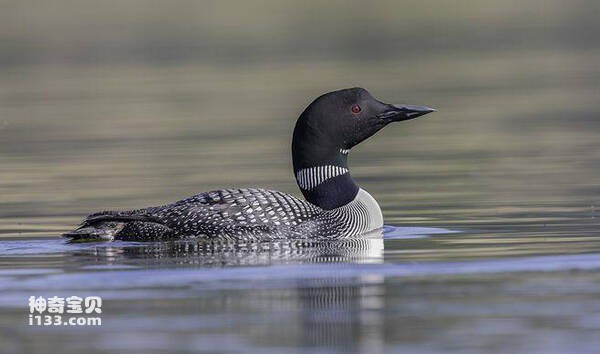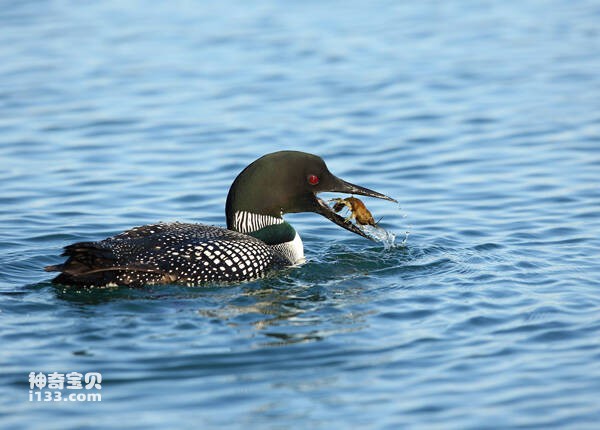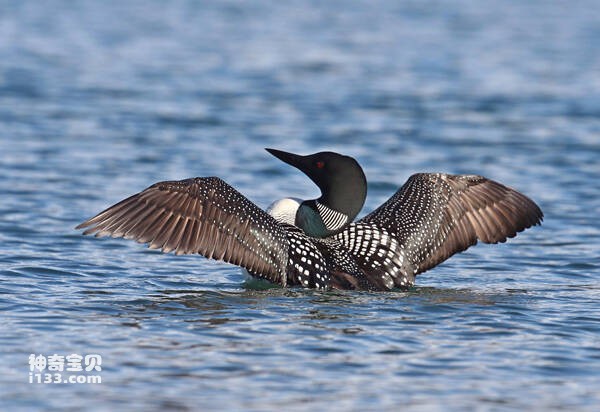Gavia immer
IUCN
LCBasic Information
Scientific classification
- name:Gavia immer
- Scientific Name:Gavia immer,Colymbus immer immer,Common Loon
- Outline:Waterfowl
- Family:
Vital signs
- length:70-90CM
- Weight:3.7-4.48kg
- lifetime:About 9 years
Feature
They have a straight, thick "dagger-like" beak, which is black during the breeding season and grey during the rest of the year
Distribution and Habitat
It is most abundant in Canada and the northern United States. It ranges from western Greenland, across Canada and the northernmost tip of the United States, and breeding grounds include Alaska around lakes and other waterways. They overwinter along both coasts of North America, all the way to Baja California Sur and Texas. There are also breeding populations in Iceland, and the species is a regular winter visitor to the west coast of Europe.
Nest on lakes and large ponds. Climate limits habitat choice, as common loons cannot nest on frozen water. They prefer to nest in floating vegetation on offshore islands, islets, or in shallow water. In winter, common loons migrate to shallow coastal habitats. Common loons are usually found in coastal waters and can sometimes be found in tidal affected rivers and estuaries. It is common in Arctic waters, especially in Norway and Sweden.
Appearance
The common loon usually weighs 3,700-4480 grams, is 70-90 cm long, and has a wingspan of 127-147 cm. It's a large swimming bird. Male birds are usually larger than female birds, but they are similar in appearance. They have a straight, thick "dagger-like" beak, which is black during the breeding season and grey during the rest of the year. They have black, white and grey plumage. During the breeding season, they have a black head with a pearl-like necklace of white and black, and a checkered pattern on the back of their body. In winter, their heads and backs are evenly gray, and their necks and undersides are white. The common loon has distinctive plumage during the breeding season and can be morphologically distinguished from the black-throated loon and other loon species. In winter, the common loon can be distinguished by a depression in the middle white part of the neck. Legs black and light gray. Iris wine red.
The common loon subadult is similar to the winter adu
Details
The Common Loon (Gavia immer) has no subspecies.

Common loons are migratory species. From the start of breeding in September, they migrate individually or in groups of up to 15 individuals. During migration, common loons may gather in groups of hundreds on large inland lakes overnight. During the winter, they guard a small feeding area of 0.04-0.08 square kilometers during the day, but gather together at night.
Their weight forces them to take off from the water with arduous dynamics. Once airborne, it can reach speeds of 40 kilometers per hour. Stretch your neck down slightly while flying. The common loon is an expert swimmer. They can extend their legs far from their bodies, making them very powerful underwater swimmers. However, this body structure also makes it difficult for these birds to walk. It can stay underwater for up to 3 minutes, although the dive time at a depth of about 12 meters will not exceed 40-60 seconds.

Common loons use visual displays and vocalizations to communicate. They use 6 visual displays and 5 vocal types. These displays and vocalizations are used for courtship, territorial disputes, communication between pairs and offspring, and among group members, and for alerting. Silent in winter, noisy during breeding and mating, loud sniggering and the most primitive repeated grumbling. During flight, the female makes a short barking sound.
The common loon is a predator, locating fish by sight and diving deep to catch them. They usually fish in water 2-4 meters deep. Because of their reliance on sight, clean water is crucial for the common loon. Adult birds catch most of the food they need underwater. Will bring the larger food to the ground before eating. It also eats other aquatic animals, mainly Marine fish up to 28 cm long, including cod, herring, haddock, bass, and eels, but also small mollusks, crustaceans such as crayfish and shrimp, and some aquatic plants. The method of drinking water is to use your own lower beak spoon, and then tilt your head back to swallow.

Common loons may be vulnerable to attacks by large Marine mammals, such as sea otters, and large birds of prey, such as bald eagles and ospreys. Gulls, crows, vultures, raccoons, skunks, mink and weasels, snapping turtles and large fish are the natural enemies of the common loon chick.
Common loons usually nest on islands to avoid predation, and land predators are less common on these islands. When approached by a predator, they will frantically charge the predator and try to attack the predator through the abdomen, head, neck or back and drive them away.
The common loon breeds in spring and summer, once a year. Monogamy, with a partner for life. Male and female birds arrive at the breeding area together in early spring. Will establish 40-1200 acres of territory, and regularly patrol. The common loon uses physical displays and vocalizations to defend its territory and seek a mate. For example, male birds use loud calls to signal that their territory has been occupied. After the courtship display, the male and female birds swim ashore, where mating takes place. When mating, the male stands on the female's shoulders with his head extended and beyond her.

Common nesting, usually on the unforested banks of lakes. The nest is usually built on an island or peninsula jutting into the water, usually on the shore near deep water, so that both parents can swim back and forth undetected by predators. The nest is placed in the ground near the water, and is marked with a shallow pit, about 0.6 meters in diameter, and the nest material includes soil, grass, moss or vegetation. During the nesting period, each pair should be spaced at least 400-500 meters apart.
Females lay eggs between May and June, laying 1-3 eggs per clutch and 1 egg every other day, olive brown with some black spots. Hatching begins from the time the first egg is laid, with both sexes participating in brooding and protecting the nest together. The incubation period lasts 26-31 days. The chicks hatch asynchronously, at most one day apart. After hatching, they stay in the nest for a day or two, after which they leave the nest with their parents and rarely return to shore. The nestling period lasts 2-3 months, during which the baby birds accompany their parents around the area, sometimes riding on the back of one parent for several weeks. The parents feed the chicks a meal every hour. They also protect chicks from predators by vocalizing and swimming away from predators to distract them from the birds. During the first few weeks of calving, parents often carry their chicks on their backs. If the bird is cold, the parents may return to shore with the bird and shelter it under its wings. The baby birds begin diving at close quarters just two days after birth, eventually reaching a depth of 3 meters. And it can fly within 2-3 months. Once able to fly, the young common loon can become independent of its parents. The common loon is thought to be a relatively long-lived bird. The common loon is known to live at least nine years in the wild.
Common loons are primarily threatened by habitat loss or degradation. They are highly sensitive to human disturbance caused by play or development in secluded lakes. They are also threatened by industrial pollutants, such as the accumulation of mercury and other heavy metals, which can accumulate on lobsters, the common loon's main food, and slowly poison them. Acid rain kills phytoplankton and disrupts the food chain on which lobsters depend. Oil spills are deadly to common loons, which are unable to fly, dive or swim when their feathers become saturated with oil. Lead poisoning from ingestion of lead drops and entanglement in fishing nets were other causes of death.
Listed on the International Union for Conservation of Nature Red List of Threatened Species (IUCN) 2018 ver 3.1 - Not Threatened (LC).
Protect wild animals and eliminate wild meat.
Maintaining ecological balance is everyone's responsibility!








